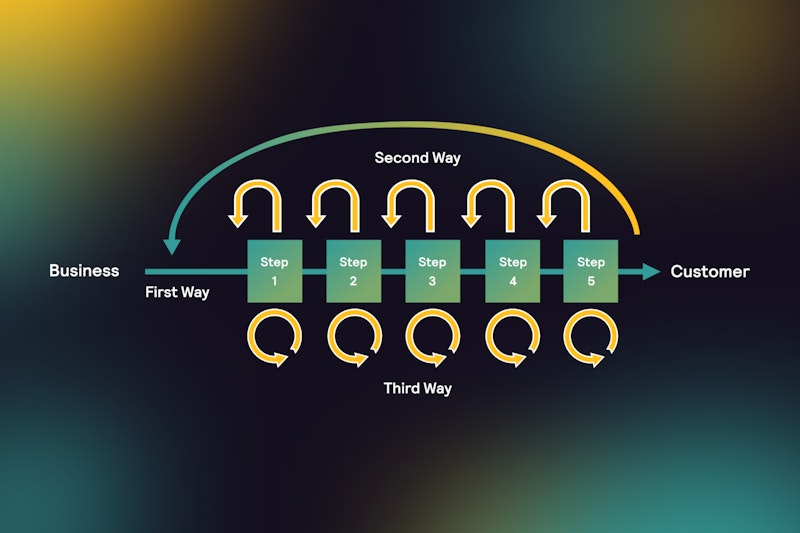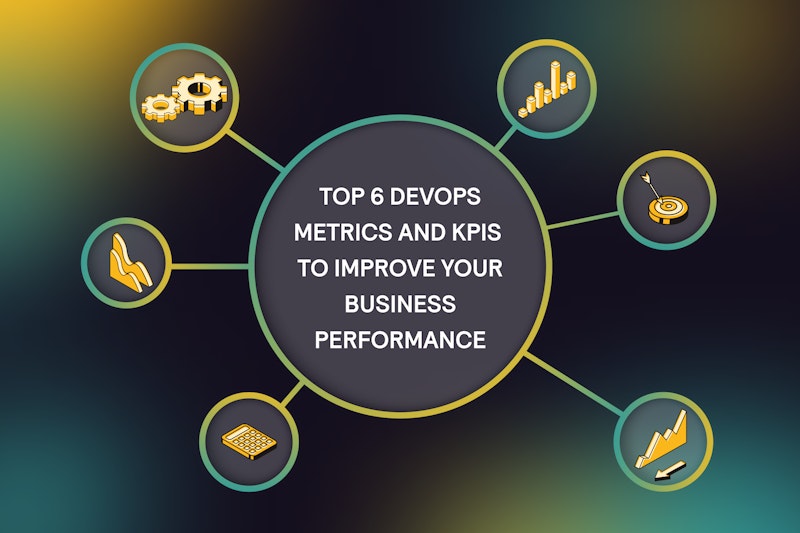Here are the technologies and methodologies we think will be most impactful for DevOps this year.
1. Kubernetes
For almost 50% of organizations surveyed in Datadog's 2022 survey, Kubernetes (K8s) was the technology of choice to deploy and manage containerized environments. In research conducted by IBM, approximately 85% of container users reported that containerization improved their productivity thanks to benefits like source control, automated scaling, and the ability to reuse code across systems.
Kubernetes enjoys active support like no other container orchestration platform. It was developed by Google and has major support from cloud providers like Amazon Web Services, Microsoft Azure, and Oracle Cloud. As an open-source platform, it has an active community that frequently rolls out new add-ons to extend its functionality.
Let's look at an example. The fashion retailing company Nordstrom adopted a K8s containerized environment so developers could deploy faster and use their resources more efficiently. According to the company’s senior engineer, containerizing with Kubernetes improved CPU utilization by ten times compared to their virtual machine setup.
2. Value stream mapping
In the 2020 Future of DevOps report, Gartner agreed that 70% of organizations would use value stream mapping in 2023 to enhance their DevOps pipeline and accelerate customer value delivery.
Value stream mapping (VSM) helps companies visualize DevOps processes and the information flow in their organization by constructing a flow chart of their processes. They can then assess each item in the chart for resources needed, lead times, and process outcomes. After careful evaluation, they can differentiate between investing in time that adds value versus wasted time.
Automating manual processes sporadically is unwise. Value stream mapping helps IT companies prioritize critical operations that provide immediate benefits. Sometimes they even discover that their workflow lacked essential activities they assumed were incorporated.
3. Infrastructure as code and GitOps
The infrastructure as code (IaC) framework applies automation to infrastructure provisioning. GitOps expands on these concepts with DevOps automation tools to optimize version control, merge requests, and CI/CD workflows. Most importantly, GitOps stores configuration information in a Git repository, which acts as a single source of truth.
In other words, GitOps automatically optimizes network configuration, storage, and deployment environments. This offers several benefits to DevOps teams. They get infrastructure updates, so the infrastructure is always optimized for continuous deployment. Plus, it lets cross-functional teams access common standards and vocabulary.
International management company Mettle adopted a GitOps self-service platform to handle its infrastructure and Kubernetes clusters. This allowed their team to deploy code with minimal input from the operations team. As a result, they increased production speed by 50% and significantly reduced the mean time to recovery.
4. Blockchain
Blockchain lets DevOps teams record all transactions (including updates, tests, and outcomes) in an immutable database. Team members, project managers, and auditors can easily access a project’s status on the blockchain anytime. This takes transparency to a new level, which is especially helpful for projects with multiple teams.
Smart contracts can automate some resource-heavy tests — algorithms can execute the tests, assess the results, and launch remediation processes if a result doesn’t meet requirements. They can also track who owns certain information, log access attempts, and report service management agreement violations.
A contract layer can extend to any activity in a network. For more information, we advise you to read our article about Blockchain in DevOps.
5. AIOps
AIOps incorporates artificial intelligence (AI) and machine learning technologies. AI-powered software can identify coding errors, predict issues, and optimize code. Some mature organizations experiment with algorithmic models that detect inefficient coding practices and offer suggestions for optimization.
GitLab’s 2022 Global DevOps Survey showed that 51% of mature DevOps teams use AI and machine learning to check for code errors. About 56% deploy AI-powered software for dependency scans, and 61% use it for license compliance checks.
A majority of security professionals in the same study believed acquiring AI and machine learning skills would benefit their careers the most in the upcoming years. In 2022, 60% of DevOps teams used it to scan containers (10% more than in 2021). In addition, about 53% deploy these technologies for SATS scans, and 55% use them for DAST scans (an 11% year-over-year increase).
6. Low-code & no-code
Companies will use more low-code and no-code solutions in 2023. These visual software development environments with pre-made code and templates help you design apps, automate processes, and manage content with minimal manual coding. About 33% of Mendix’s 2021 State of Low-Code survey respondents reported using low-code to build mission-critical apps.
Low-code and no-code platforms can optimize resources. For example, according to Mendix, some developers said that low-code projects reduced their costs by 53% and increased development speed by 56%. They also reported more efficient collaboration — a vital factor for DevOps teams.
Some low-code platforms are even simple enough that non-technical staff can participate in development. This means business analysts, citizen developers, and subject matter experts can contribute to development projects.
7. Serverless environment
Many DevOps teams rely on serverless (cloud-native) environments hosted by third-party providers, and adoption is expected to continue in 2023. The cloud providers take care of server management, infrastructure scaling, and resource provisioning.
With a serverless environment, a company can eliminate expensive and time-consuming hardware purchasing, configuring, and troubleshooting. At the same time, their developers can avoid tedious aspects of system maintenance.
For example, an energy-based enterprise, Power Ledger, used Google Cloud to host its blockchain trading platform and provide remote access to clients. Google’s serverless platform reduced the company’s infrastructure management time from one full-time role to less than five hours per week. It also decreased the company’s cloud maintenance cost by 30%.
8. Microservices
Microservices is a long-standing DevOps trend expected to grow in 2023 that involves splitting an app’s backend into loosely coupled isolated single-purpose components. Isolating components lets different teams code, test, and deploy apps with less expensive overhead. Accelerate’s 2022 State of DevOps Report showed that proper microservice implementation resulted in better app performance, reliability, and throughput.
Loose coupling also reduces downtime. For example, developers can make large-scale changes to different services without the entire system going down. They can work on one microservice without disrupting the others.
According to Accelerate’s report, DevOps teams that used microservices were more likely to use practices that drive continuous improvement. One example is site reliability engineering (SRE) principles, which involve setting and regularly reviewing reliability goals.
9. Multi-cloud strategy
Flexera’s 2021 State of the Cloud report shows that 92% of enterprises had already adopted a multi-cloud approach. Most of these organizations used as many as five different cloud providers. Why?
A multi-cloud strategy gives DevOps enterprises more freedom to pick the best environment for every workload. The ability to run applications on different clouds also makes companies more resilient because they’re not as dependent on a single vendor — orchestrating workloads across several clouds can prevent service disruptions if one cloud goes down.
A well-designed multi-cloud approach also improves cybersecurity. Organizations with consolidated and modern cloud architectures are easier to refresh than on-premise technologies. In addition, cloud-based technologies work more effectively with broader IT infrastructure contributions. And based on the same report, companies are more likely to achieve high levels of automated security with integrated technologies.
10. DevSecOps
DevSecOps is a shift-left approach, which means integrating continuous security testing into every stage of application development. GitLab’s 2022 DevSecOps survey noted that 42% of teams actively used DevSecOps practices to reduce risks.
DevOps and DevSecOps are intertwined, as both rely on version control and CI/CD. Automated security scans at each stage of the development process reduce vulnerabilities when code is deployed to production. It also saves money because issues are generally less expensive to remediate early on.
11. Chaos engineering
Chaos engineering means deliberately destabilizing systems and applications to find hidden weaknesses. Even in its simplest form, it can help DevOps teams find faults they didn’t know existed. This includes failure points, security vulnerabilities, performance bottlenecks, and excessive technical debt.
Remember how Twitter's new owner had to gather the whole team and spend sleepless nights to figure out its back end? As your systems get more complex, chaos engineering helps keep your knowledge and documentation robust. Ironically, chaos testing maintains discipline so that your team knows precisely how your system works.
Gartner predicts that chaos engineering can reduce unplanned downtime by up to 20%. That’s why they believe that about 40% of companies will make this practice part of their DevOps workflow in 2023.
12. DevOps platforms
GitLab found that about one-third of DevOps teams surveyed still used homegrown and third-party solutions. However, large organizations with multiple development teams and departments for security and compliance may have trouble connecting all their tools into an automated pipeline.
That's why about 44% of companies in 2022 used DevOps platforms that offer a comprehensive ecosystem with all the tools they need for development, IT operations, and SRE testing. These advanced platforms also come with in-depth knowledge bases, so users can easily find necessary information about each tool.








